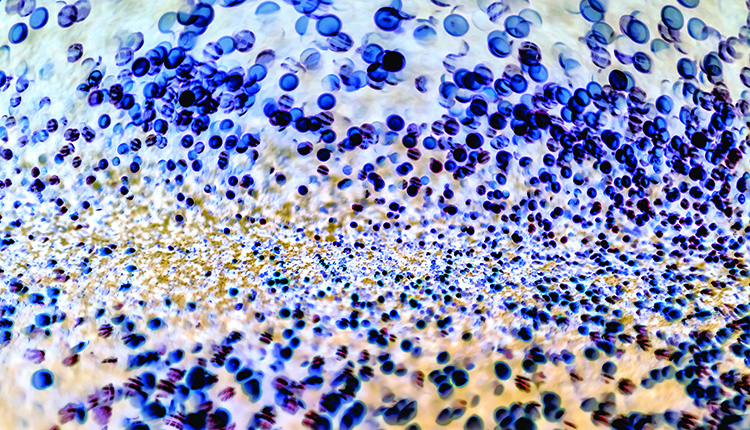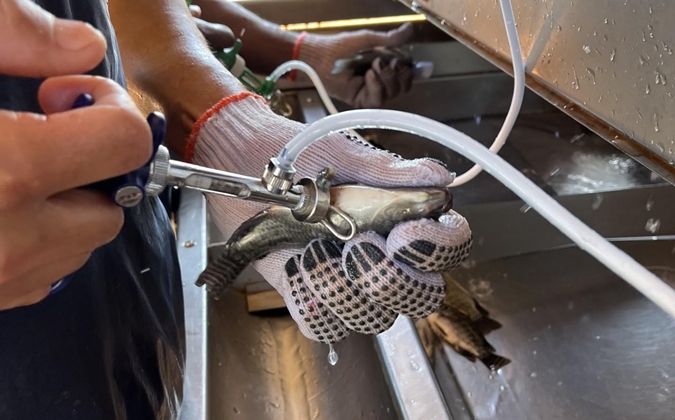
Using proteomics to understand infectious disease response in aquaculture
By Robert Stewart, PhD candidate at the Roslin Institute
Due to unprecedented challenges, Scottish salmon farms witnessed high losses of fish in 2022, double of the previous year, data from the Fish Health Inspectorate has shown.1 At the same time, and in spite of this, Scotland produced more farmed fish than ever before.
Despite universal adoption of vaccination programs and an unrelenting focus on preventative fish health management, there is still a clear need for further improvements in the protection of farmed fish against infectious diseases, parasites and environmental conditions.
While gene editing currently remains a technology excluded from our tables, improvements in vaccines, selective breeding and engineering controls remain our best tools in reducing the impact of infectious disease.
Research underway at the Roslin Institute and University of Aberdeen aims to improve the impact of vaccination through improved understanding of disease.
Immune-system unknowns driving work
Vaccination at smoltification is the best option we have for protecting farmed fish from a broad range of viruses, bacteria and fungi. Yet to date, most research on vaccination has been led by trial and error, relying on the inactivation or attenuation of pathogens, rather than identifying the desired immunological response in the fish and then reverse engineering a vaccine from that response.
This process is driven in part by a fundamental lack of understanding of the fish immune system. Despite Atlantic salmon being the highest-value aquaculture species globally, we know relatively little about the function of most of the genes in its genome and even less about the repertoire of proteins, or proteome, encoded by these genes.
Without understanding the parts that constitute this puzzle, it is almost impossible to put them together and understand how effective vaccines lead to protection, and why many vaccine candidates are ineffective.
Current academic research focuses on studying and exploiting the variation of reproduction, productivity and disease resistance in the genome of salmon populations. However, when DNA is translated to protein, the complexity expands and with this our understanding wanes.
Genes are made up of four chemicals, or bases — adenine, thymine, cytosine and guanine — and the combination of these relatively simple chemicals can generate enough diversity to encode all the information needed for life. However, proteins are where things can get more difficult to untangle.
New technology helps shed light on proteins
Combinations of three base chemicals in DNA codons contain instructions for chains of amino acids that are far more complex than the DNA that contains the instructions. Instead of only four components available for DNA sequences, proteins can be made up of more than 20 different amino acids, each of them larger and more complex than DNA bases.
As well as the additional complexity from the possible permutations of units, proteins fold into complex, somewhat unpredictable structures when they are formed, compared with the incredibly consistent structure of the DNA double helix. Herein lies the difficulty and the reason why we know relatively little about the proteome of the salmon compared to its genome.
Here’s where technological advances come in. Thanks to high-throughput mass spectroscopy coupled with liquid chromatography, we are now starting to unravel the complex mixture of proteins in the salmon proteome, to understand how variation in the DNA sequence of a gene can lead to alterations in the physical, observable characteristics, or phenotype, of an individual.
By breaking up the complex, long chains of proteins into smaller, more manageable fragments, and separating these small fragments over time, we can measure the abundance of these fragments and then assign them back to the protein from which they came. Using this so-called bottom-up mass spectroscopy technique we can detect, identify and quantify the proteins of the proteome.
Using this technique, in addition to more traditional proteomics techniques such as antibody detection and polymerase chain reaction, our research group aims to uncover the biological processes leading to disease resistance in fish.
Gene group focus
In particular, we are currently interested in a group of genes named tripartite motif (TRIM), which give rise to proteins which are crucial in humans for regulation of the immune response. These proteins are enzymes called ubiquitin ligases. Ubiquitin ligase enzymes attach a molecule of ubiquitin to other proteins, which can have drastic and varied implications on this protein’s fate.
The ubiquitin-signaling pathway is linked to the breakdown of proteins by the proteasome, cellular signaling and activation of proteins. It is a complex and dynamic system that has a critical function in regulating immune response in humans and model species such as Zebrafish.
We hope to bring new understanding of the mechanism of these TRIM proteins, as well as the changes at the cellular level in all proteins in response to viral infection. The work could also shed light on the mechanisms the viruses are using to evade the host immune response.
Vaccination and breeding hopes
There are many potential practical implications of our 4-year project, which is sponsored by both Biotechnology and Biological Sciences Research Council and Zoetis Partnership Platform in connection with the Easter Bush Research Consortium.
By developing an understanding of the proteomics of disease progression and disease resistance, we aim to discover mechanisms to improve vaccination, identify selective-breeding candidates and understand the viral proteins that manipulate the salmon immune system to allow infection.
Although the initial focus is on two of the main viruses affecting Atlantic salmon, the systems and tools we’re developing will be transferable to other viruses and pathogens, and other species of fish.
1 The Scottish Government. 2023 Feb 1. Fish Health Inspectorate: Mortality Information. Scottish Government. [accessed 2023 Mar 1]. https://www.gov.scot/publications/fish-health-inspectorate-mortality-information/
Posted on: April 10, 2023






